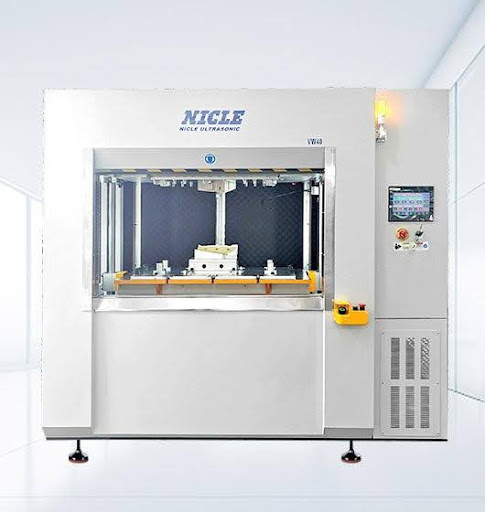Vibration welding is a widely used method for joining thermoplastics, offering high-strength, consistent welds without the need for adhesives or additional materials.
This process relies on frictional heat generated by controlled vibrations to melt and fuse plastic components. It is extensively used in industries such as automotive, medical, electronics, and industrial manufacturing due to its reliability and efficiency.
This article provides a step-by-step breakdown of how vibration welding technology works, covering everything from clamping the parts to cooling and inspection.
Understanding of Vibration Welding Technology
Vibration welding technology is highly valued for its precision and reliability, especially in the manufacturing of plastic parts.
The process works by applying high-frequency vibratory motion to the parts being joined, which generates frictional heat at the interface. This heat melts the plastic at the joint, allowing the parts to fuse together.
It’s commonly employed for its ability to create strong, reliable welds with minimal distortion. Here’s a detailed breakdown of how the vibration welding process works:
Step 1: Clamping the Parts
The first step in plastic vibration welding technology is securing the two plastic components in place. A vibration welding machine uses specially designed fixtures to hold the parts with uniform pressure. Proper clamping is crucial to prevent misalignment or movement, which can lead to weak welds.
Factors Affecting Clamping Quality
- Custom fixtures are designed to fit the exact shape of the plastic parts.
- Softer plastics require careful handling to avoid deformation.
- Complex shapes may need additional support to ensure stability.
For precision welding, manufacturers often use vibration welding technology to ensure optimal results.
Step 2: Applying Vibrations
Once the parts are clamped, the vibration welder technology generates rapid back-and-forth movements. These linear vibrations create friction at the interface, which produces heat and starts the melting process.
Key Vibration Parameters
- Frequency range: 100 to 240 Hz
- Amplitude: 0.5 mm to 3 mm, depending on the material
- Duration: Typically 1 to 5 seconds
By adjusting these settings, manufacturers can achieve precise control over the welding process and ensure strong, repeatable bonds.
Step 3: Heating Through Friction
As the vibrations continue, the temperature at the interface rises due to friction. This heat melts a thin layer of plastic, creating a molten phase between the two parts.
Factors That Affect Heat Generation
- Welding pressure controls the amount of friction and heat.
- Different plastics have varying melting points.
- Vibration frequency and amplitude adjustments impact heat distribution.
The goal is to generate enough heat to create a uniform melt layer while avoiding overheating, which could degrade the plastic.
Step 4: Stopping Vibrations & Applying Pressure
Once the material reaches the required melting point, the machine stops vibrating abruptly. At this stage, vibration welding machine technology applies additional pressure to the parts, pressing them together while the molten plastic cools.
Why This Step Matters
- Ensures strong fusion at the interface through molecular bonding.
- Prevents weak spots or inconsistencies with even pressure distribution.
- Reduces the risk of defects like porosity by minimising air traps.
Proper pressure application is essential for ensuring long-lasting, high-quality welds.
Step 5: Cooling & Solidifying the Weld
The welded parts remain clamped while they cool and solidify. This phase determines the final strength and durability of the weld.
Cooling Techniques
- Natural cooling allows the weld to stabilise at room temperature.
- Forced cooling using air or water speeds up production.
- Controlled cooling rates prevent warping and internal stress.
For high-volume manufacturing, standard plastic welding equipment can help streamline the process and improve efficiency.
Step 6: Quality Inspection
After cooling, the welded parts undergo inspection to ensure they meet industry standards. Various tests assess weld strength, durability, and integrity.
Common Quality Control Methods
- Visual inspection checks for surface defects or misalignment.
- Strength testing measures the mechanical robustness of the weld.
- Leak testing ensures airtight seals in critical applications.
- Dimensional analysis confirms that the final product meets specifications.
Regular quality checks help prevent defects and ensure long-term performance.
Advanced Applications of Vibration Welding
Vibration welding is an incredibly versatile and efficient joining process, especially for plastic materials. Beyond the basic industrial applications, vibration welding is also being increasingly used in advanced and specialized applications.
These applications leverage the precision and reliability of vibration welding to meet the demands of modern manufacturing. Here’s a look at some advanced uses of vibration welding:
Automotive Industry
In vehicle manufacturing, linear vibration welding technology is used to join plastic components, such as:
- Fuel tanks require leak-proof welding for safety.
- Air intake manifolds need strong, durable seals.
- Bumpers and dashboards rely on vibration welding for structural integrity.
Medical Device Manufacturing
Medical products require precise, contamination-free welds. Common applications include:
- Sterile packaging prevents contamination of medical instruments.
- Prosthetic devices need durable and safe connections.
- Surgical tools and equipment require strong, hygienic welds.
Industrial Equipment & Electronics
- Electrical enclosures protect sensitive electronics from environmental factors.
- Household appliances use vibration welding for components like vacuum cleaner housings and water filtration systems.
- Structural plastic components provide strength and stability in industrial applications.
Comparing Vibration Welding to Other Methods
Here’s a breakdown of how vibration welding compares to other popular plastic welding methods, such as ultrasonic welding, hot plate welding and laser welding:
| Welding Method | Speed | Strength | Complexity | Material Suitability |
|---|---|---|---|---|
| Vibration Welding | Fast | High | Moderate | Thermoplastics Only |
| Ultrasonic Welding | Very Fast | Moderate | Simple | Thin Plastics Only |
| Hot Plate Welding | Moderate | High | Complex | Large Parts |
| Laser Welding | Slow | High | High Precision | Clear Plastics Only |
Compared to other methods, vibration welding technology offers a balance of speed, strength, and flexibility, making it ideal for high-performance plastic components.
Key Benefits of Vibration Welding
The benefit of vibration welding for precision include:
Consistent Results – Vibration welding ensures uniformity in the heat distribution, which leads to consistent, high-quality welds every time.
Strong Welds – The process creates solid, durable bonds that are often stronger than the base material itself, making it ideal for high-strength applications.
Minimal Distortion – Since the process generates less heat than traditional welding methods, it reduces the risk of warping or distorting the parts.
Efficiency – Vibration welding is fast and allows for precise control over the process, increasing throughput and minimizing waste.
Versatility – It works well with a variety of plastic materials, making it a go-to solution for manufacturers who work with different types of plastics.
Environmental protection – It reduces material waste and is environmentally friendly.
Future Trends in Vibration Welding
As industries push for more efficient and sustainable manufacturing, vibration welding machine technology continues to evolve. Emerging advancements include:
- Automated welding systems use AI-powered robots for improved precision.
- Smart monitoring allows real-time data collection for better process control.
- Eco-friendly materials are being researched for recyclable and biodegradable plastics.
- New techniques are enhancing weld strength and durability.
By adopting these innovations, manufacturers can improve productivity while reducing environmental impact.
Conclusion
Vibration welding is a critical technology for industries that require strong, precise, and efficient plastic joining solutions. By following a well-controlled process—from clamping and vibration to cooling and inspection—manufacturers can produce high-quality welds with minimal defects.
With ongoing advancements in vibration welder technology, the future of plastic welding looks even more promising, offering greater efficiency, sustainability, and reliability for a wide range of applications.







